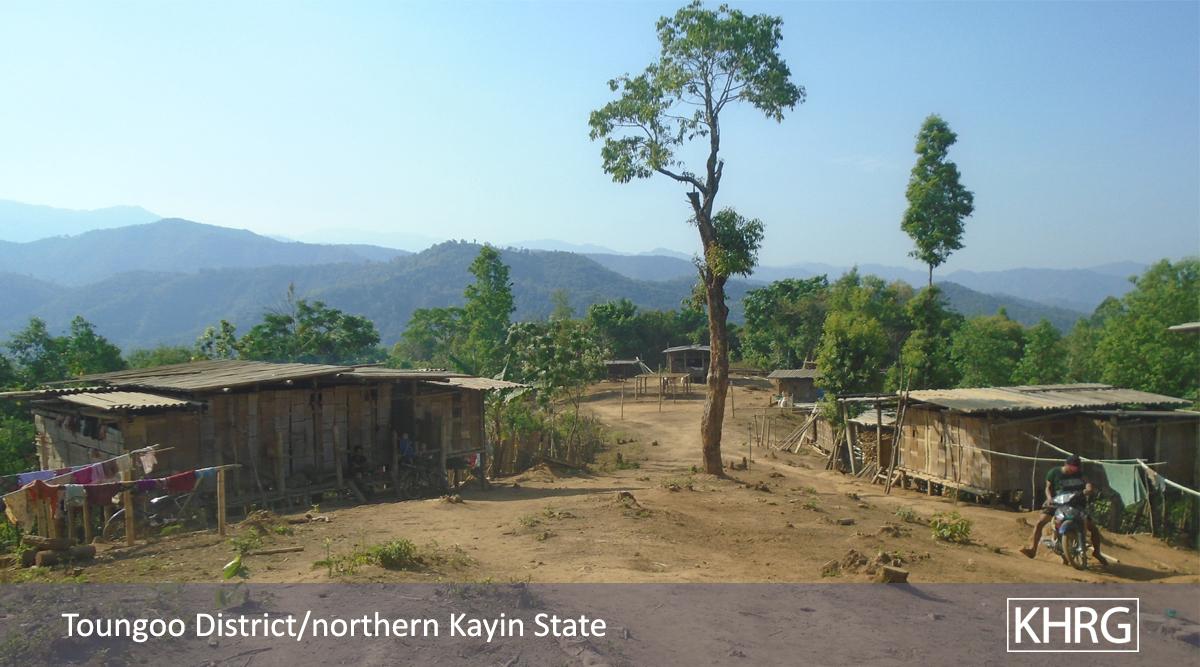From 2016 to the present, the Tatmadaw has been active in Htantabin (Htaw Ta Htoo) and Thandaunggyi (Daw Hpa Hkoh) townships, which has caused the local communities to worry about the possibility of renewed conflict. The Tatmadaw is building a military road, rotating their battalions and patrolling the area. In Htantabin Township, there have been many cases of land confiscations by companies. Many agricultural lands and houses have been flooded by the construction of the Thaut Yay Khat dam.
Situation Update | Htantabin and Thandaunggyi townships, Toungoo District (Early 2016 to February 2018)
The following Situation Update was received by KHRG in February 2018. It was written by a community member in Toungoo [Taw Oo] District who has been trained by KHRG to monitor human rights conditions. It is presented below translated exactly as originally written, save for minor edits for clarity and security.[1]
Tatmadaw Military Activities
In November 2017, the Tatmadaw replaced their Tactical Operations Command (2) in Pa Leh Wah village and the Light Infantry Battalion (555) in Bu Hsar Kee, Htee Htaw Per and Khoh Daw Koh villages. After this rotation, the original Operations Command and Battalions returned to their regiments.
On November 14th 2017, The Tatmadaw began building a road in Kaw Thay Der, Bu Hsar Kee, and Kay Poo. On November 21st 2017, 10 Burmese soldiers were seen returning to Htee Mu Htah with a large number of weapons with them.
Local populations are banned from fishing in Hse Kyee Gran village. To enforce this decision, the Tatmadaw Military Operations and LIB started patrolling in Hse Kyee Gran. The local community is afraid to travel to their fields to plant crops because of the continued presence of Tatmadaw army camps in Kaw Thay Der area. Many people are afraid of being injured by landmines. Tatmadaw army camps that are based near local villages have been reinforced, exacerbating the feeling of insecurity. The local community is worried by the ongoing Tatmadaw military presence.
The Tatmadaw was involved in the reconstruction of Pa Leh Wah Bridge. A local community member has reported that Tatmadaw soldiers are transporting more rations to their army camps in the area than in the past. He is worried that if conflict resumes in the area, the local community will suffer more than in the past because the Tatmadaw is better equipped.
In February 2018, Tatmadaw soldiers were building a road from Leik Tho to Kyauk Lone Kyee. A local expressed concern that the Tatmadaw would cut down the forest, enter into the villages, and confiscate the lands of community members.
Land Confiscations and Property Damage
Htaw Ta Htoo Township has experienced flooding due to the construction of the Thauk Yay Khat dam. Roads have been damaged, and local communities have experienced livelihood problems because of the flooding of their homes and agricultural lands.
In this area, there has also been an increase in land confiscations by the Kaung Myanmar Aung Company, Golden Energy and Recourses (Shwe Swan Ain) and Asia World Company. Although some households received compensation, many families are still struggling to support themselves and secure their livelihoods.
Progress in Accessing Education
There are two types of schools in Htaw Ta Htoo Township: Myanmar government and Karen National Union (KNU) schools. Many children were unable to attend school during the conflict period. In Htoe Lwee Wah, the community rebuilt their school and obtained recognition by the KNU. It is often difficult for families to send their children to high school, but this school also provides support to children whose families cannot pay their tuition fees. This school also admits children from neighbouring schools without requiring transfer certificates. The difficulties of transferring from one school to another are a barrier to continuing education for children in Southeast Myanmar.
Footnotes:
[1] KHRG trains community members in southeast Burma/Myanmar to document individual human rights abuses using a standardised reporting format; conduct interviews with other villagers; and write general updates on the situation in areas with which they are familiar. When writing situation updates, community members are encouraged to summarise recent events, raise issues that they consider to be important, and present their opinions or perspective on abuse and other local dynamics in their area.





